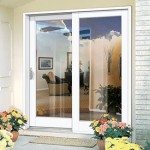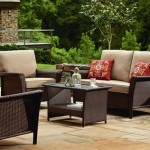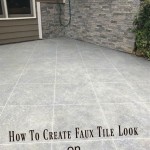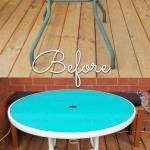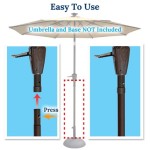What Is The Best Paint To Use On Metal Patio Furniture Covers?
Selecting the appropriate paint for metal patio furniture covers is crucial for preserving the appearance and extending the lifespan of these outdoor accessories. Metal, while durable, is susceptible to corrosion and rust when exposed to the elements. The right paint not only provides an aesthetic upgrade but also acts as a protective barrier against moisture, ultraviolet (UV) radiation, and temperature fluctuations. Considering various paint types, surface preparation techniques, and application methods will ensure a lasting and visually appealing finish for metal patio furniture covers.
The choice of paint significantly impacts the longevity and appearance of painted metal. Different paint formulations offer varying degrees of protection and aesthetic qualities. Therefore, a thorough understanding of the available options and their respective characteristics is essential for making an informed decision. Factors such as the type of metal, the desired finish, and the expected environmental conditions should all be taken into account.
Understanding the Unique Challenges of Painting Metal
Painting metal presents specific challenges that differ from painting wood or other materials. Metal surfaces are generally smooth and non-porous, which can make it difficult for paint to adhere properly. Without proper surface preparation, paint can easily chip, peel, or flake off, leaving the metal exposed to the elements. Furthermore, the presence of rust or corrosion can exacerbate these issues, requiring more extensive preparation and specialized paint products.
One of the primary concerns when painting metal is the risk of rust. Rust is an electrochemical process that occurs when iron or steel is exposed to oxygen and moisture. The rust then weakens the metal over time. Therefore, any paint used on metal patio furniture covers must provide a robust barrier against moisture to prevent the formation and spread of rust. Paints with rust-inhibiting properties or the application of a rust-inhibiting primer can significantly improve the long-term protection of the metal.
Another challenge is managing the temperature fluctuations that metal patio furniture covers endure. In direct sunlight, metal surfaces can become extremely hot, causing the paint to expand. Conversely, during cold weather, the metal contracts. This constant expansion and contraction can stress the paint film, leading to cracking and peeling. Paints formulated to be flexible and durable are better suited to withstand these temperature changes.
Exploring Different Types of Paint for Metal
Several types of paint are suitable for use on metal patio furniture covers, each with its own advantages and disadvantages. Oil-based paints, acrylic paints, and specialized metal paints are among the most commonly used options. Understanding the characteristics of each type will help to determine the best choice for a specific application.
Oil-based paints have been traditionally used for metal surfaces due to their durability and excellent adhesion. These paints form a hard, protective layer that is resistant to scratches and abrasion. Oil-based paints also offer good resistance to water and moisture, making them effective at preventing rust. However, oil-based paints have several drawbacks, including a longer drying time, the need for mineral spirits for cleanup, and a higher volatile organic compound (VOC) content, which can be harmful to the environment. The fumes emitted during application can also be unpleasant and potentially hazardous.
Acrylic paints, particularly acrylic latex paints, are a popular alternative to oil-based paints. Acrylic paints are water-based, making them easier to clean up and producing lower VOC emissions. They also dry faster than oil-based paints and are generally more flexible, which helps them to withstand temperature changes without cracking. Acrylic paints offer good color retention and are available in a wide range of colors and finishes. However, acrylic paints may not be as durable or as resistant to abrasion as oil-based paints, especially in high-traffic areas. The adhesion of acrylic paints can also be less reliable on smooth metal surfaces, requiring careful surface preparation and priming.
Specialized metal paints are specifically formulated for use on metal surfaces and often contain rust inhibitors and other additives to enhance their performance. These paints typically offer superior adhesion, durability, and corrosion resistance compared to general-purpose paints. Some specialized metal paints are direct-to-metal (DTM) paints, meaning they can be applied directly to bare metal without the need for a primer. DTM paints often contain a combination of epoxy resins and acrylic polymers, providing a tough and flexible finish that is resistant to rust, scratches, and UV damage. While specialized metal paints may be more expensive than other options, they can provide the best long-term protection and aesthetic results.
Another option is spray paint, which is often favored for its ease of application and ability to reach intricate areas. Spray paints formulated for metal surfaces are available in various colors and finishes, including gloss, semi-gloss, and matte. However, spray paint may not be as durable as other types of paint, and it can be prone to chipping and scratching if not applied correctly. Multiple thin coats are typically required to achieve adequate coverage and protection.
Key Considerations for Choosing the Right Paint
Selecting the appropriate paint for metal patio furniture covers involves considering several key factors. These factors include the type of metal, the existing condition of the surface, the desired finish, and the environmental conditions to which the furniture will be exposed. Taking these factors into account will help to narrow down the options and choose the best paint for the job.
The type of metal used in the patio furniture cover is an important consideration. Different metals have different properties and react differently to various types of paint. For example, aluminum is naturally corrosion-resistant, but it can still benefit from a protective coating to prevent oxidation and discoloration. Steel and iron, on the other hand, are more susceptible to rust and require a more robust protective coating. Galvanized steel, which is coated with zinc, is highly resistant to rust but requires a special primer to ensure good adhesion. Understanding the specific properties of the metal will help to determine the most suitable paint and surface preparation techniques.
The existing condition of the metal surface is another crucial factor. If the surface is already painted, it is important to determine the type and condition of the existing paint. If the existing paint is peeling or flaking, it should be removed completely before applying a new coat. If the existing paint is in good condition, it can be lightly sanded to create a rough surface for better adhesion. Rust or corrosion should be thoroughly removed using a wire brush, sandpaper, or a chemical rust remover. The surface should then be cleaned and degreased to ensure that the new paint adheres properly.
The desired finish is also an important consideration. Different finishes offer different aesthetic qualities and levels of protection. Gloss finishes are shiny and reflective, making them easy to clean, but they can also highlight imperfections in the surface. Matte finishes are less reflective and provide a more subtle look, but they may be more difficult to clean. Semi-gloss finishes offer a balance between gloss and matte, providing a good combination of aesthetics and practicality. The choice of finish will depend on personal preference and the overall style of the patio furniture.
The environmental conditions to which the patio furniture will be exposed should also be taken into account. Patio furniture exposed to direct sunlight, rain, and extreme temperatures requires a more durable and weather-resistant paint than furniture that is sheltered or used indoors. Paints with UV inhibitors can help to prevent fading and degradation from sunlight. Paints with rust inhibitors can protect against corrosion caused by moisture. Flexible paints are better suited to withstand temperature changes without cracking or peeling. The chosen paint should be able to withstand the specific environmental challenges of the location.
Ultimately, the best paint for metal patio furniture covers will depend on a combination of these factors. By carefully considering the type of metal, the existing condition of the surface, the desired finish, and the environmental conditions, it is possible to choose a paint that will provide long-lasting protection and enhance the appearance of the furniture.

How To Paint Metal Patio Furniture Green With Decor

How To Paint Metal Patio Furniture From House Home

How To Paint Metal Patio Furniture From House Home

How To Paint Metal Patio Furniture So It Looks Like A Million Bucks

How To Spray Paint Metal Outdoor Furniture Last A Long Time H2obungalow

How To Paint Metal Patio Furniture From House Home

How To Spray Paint Metal Outdoor Furniture Last A Long Time H2obungalow

How To Paint Outdoor Furniture Craving Some Creativity

Repainting My Outdoor Metal Furniture The Martha Stewart Blog

How To Paint Metal Patio Furniture So It Looks Like A Million Bucks
Related Posts



